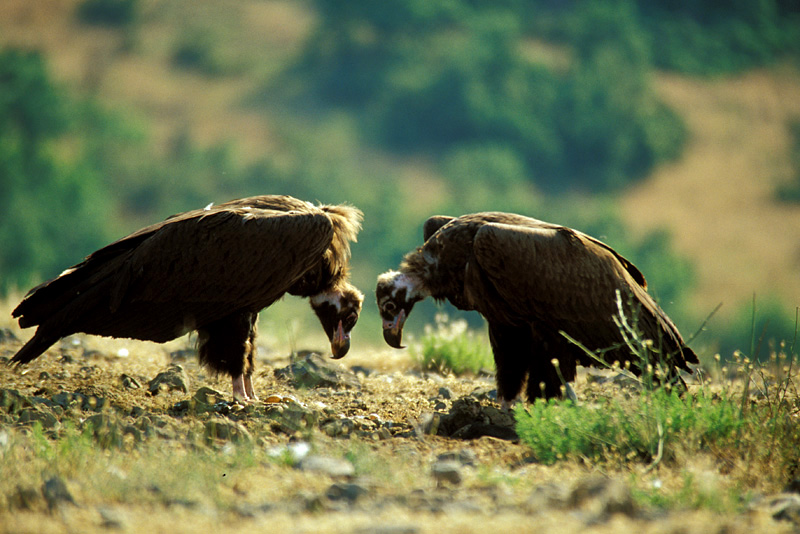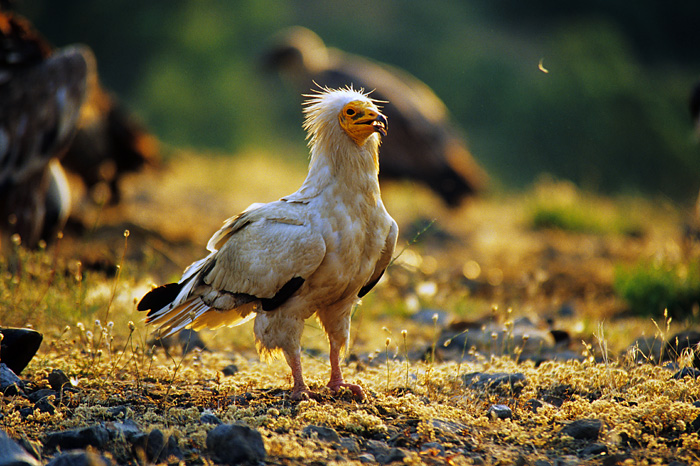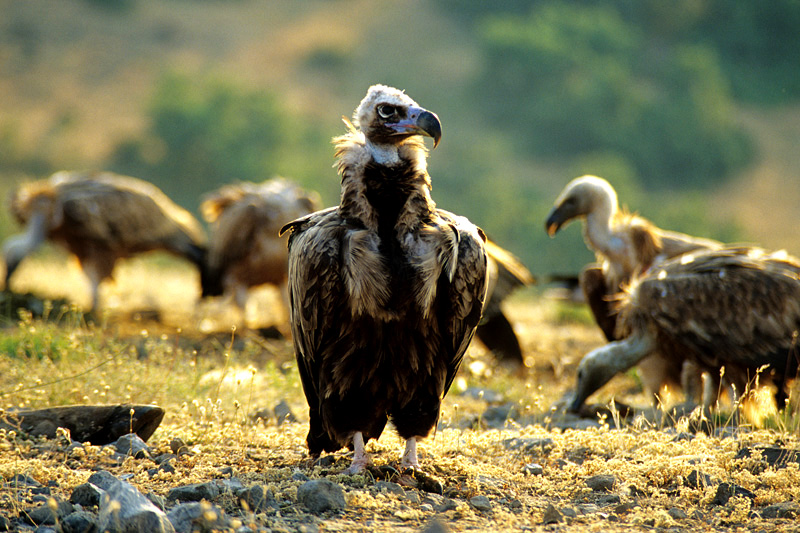
The Vultures


After a half day car travel, the final part on dirt roads, we finally arrive to Madjarovo, a desolate and semi-abandoned ex-mining city, a haunting landscape with a surreal and disquieting atmosphere. Our local contact is Christo, a young veterinarian and naturalist working for a Bulgarian environmental association contributing to protect the rare wildlife of the area.
The next morning, in early twilight, we collected a truckload of offal, bones and other butchery residues at the local slaughterhouse, and headed towards the vulture scavenging ground.
The colony, in full reproductive period, included about thirty couples of Griffon Vulture (Gyps fulvus) and fewer couples of Egyptian Vulture (Neophron percnopterus) dwelling on a knife-edge rock mountain range, imposingly overlooking the deep and narrow Arda river canyon.
The scavenging area was a fairly wide highland field at the feet of the abruptly rising rock massif, and our bird observatory was an old concrete military shelter which allowed watching the birds from inside without disturbing them. Once the offal and bones were rapidly scattered on the field, we accommodated in the bunker and our guide told us that he would come to fetch us at sunset.
The day seemed to us never ending, with the asphyxiating heat building up as the June sun implacably scorched the concrete shelter and rotted the offal spread in the fields. In spite of the fetid stench that soon stuffed the air, we stoically remained still, in the most absolute silence, crouched behind our cameras, sweating: nothing, but really nothing appeared in our sight for the whole day.
At sunset, we exhaustedly crawled out from the shelter and the just arrived Christo, with a slightly ironic smile, pointed at our backs the profile of the vultures perched on the edge of the rock spur. They were watching us, maybe they were waiting for our carcasses, and they almost managed to succeed!
With Gian Paolo and Christo we decided to change strategy. The next morning at 3:00 we were already in the old Lada Niva 4wheel drive. To gain precious time, Christo ventured the fording of the
Well before sunrise, we were in the shelter patiently waiting with mounted cameras and fingers crossed. The sun rose from the east, but nothing happened. Foreseeing another day of fruitless agony, Gian Paolo and I exchanged a terribly depressed look.
Suddenly a dull and enveloping noise like a flock of incoming helicopters shook us awake. We were taken aback and before we could understand what was happening, dozens of enormous vultures hurled on the carrion and offal a few meters from us, shaking the air with violent strokes of their powerful wings. We were in the middle of a furious scuffle where a multitude of vultures was brawling excitedly to compete for the gruesome feast: a frightening roar, feathers and pieces of meat flying everywhere. We surprisingly discovered that in the scuffle were also a few very rare Black Vultures (Aegypius monachus), probably wandering sub-adults from a near colony in
In the chaos of the feeding frenzy the powerful raptors teared open the sun-fermented swollen stomachs and ripped the entrails and the air soon became un-breathable. Our throats were burning and we had to cover our mouths with cloth. In the midst of the turmoil, we were shooting photographs at breakneck speed, throwing on the floor used film cartridges, and charging new ones in the cameras, just like firing machine-guns.
After those explosive twenty minutes, everything froze almost suddenly. The vultures, now well gorged, snoozed still with the crops bulging. Only some big white bones remained, all the rest had been wiped and silence was back. Slowly, one by one, the vultures took off back to their resting places or to feed their youngsters at the nests.
Also this banquet was completed, the colony was safe again thanks to the helping hand of man. I asked myself for how much time it will continue to be like this. In order not to suffer I did not want to think about the answer.
Some time later I learned with satisfaction that one of my photographs had been chosen and published in the frame of an article in the Airone, magazine, which explained the difficult situation of the European vultures, and advocated the need for action to guarantee their survival.
Many years have passed since but I know that the vulture colony in the Rhodope mountains is still there, sheltered by those rocky spurs as bulwarks against extinction, and that other men are fighting every day, like then, for their survival. And this thought cheers me up.

